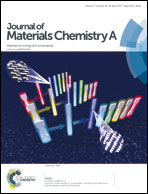Nanostructural changes in crystallizable controlling units determine the temperature-memory of polymers†
Abstract
Temperature-memory polymers remember the temperature, where they were deformed recently, enabled by broad thermal transitions. In this study, we explored a series of crosslinked poly[ethylene-co-(vinyl acetate)] networks (cPEVAs) comprising crystallizable polyethylene (PE) controlling units exhibiting a pronounced temperature-memory effect (TME) between 16 and 99 °C related to a broad melting transition (∼100 °C). The nanostructural changes in such cPEVAs during programming and activation of the TME were analyzed via in situ X-ray scattering and specific annealing experiments. Different contributions to the mechanism of memorizing high or low deformation temperatures (Tdeform) were observed in cPEVA, which can be associated to the average PE crystal sizes. At high deformation temperatures (>50 °C), newly formed PE crystals, which are established during cooling when fixing the temporary shape, dominated the TME mechanism. In contrast, at low Tdeform (<50 °C), corresponding to a cold drawing scenario, the deformation led preferably to a disruption of existing large crystals into smaller ones, which then fix the temporary shape upon cooling. The observed mechanism of memorizing a deformation temperature might enable the prediction of the TME behavior and the knowledge based design of other TMPs with crystallizable controlling units.


 Please wait while we load your content...
Please wait while we load your content...